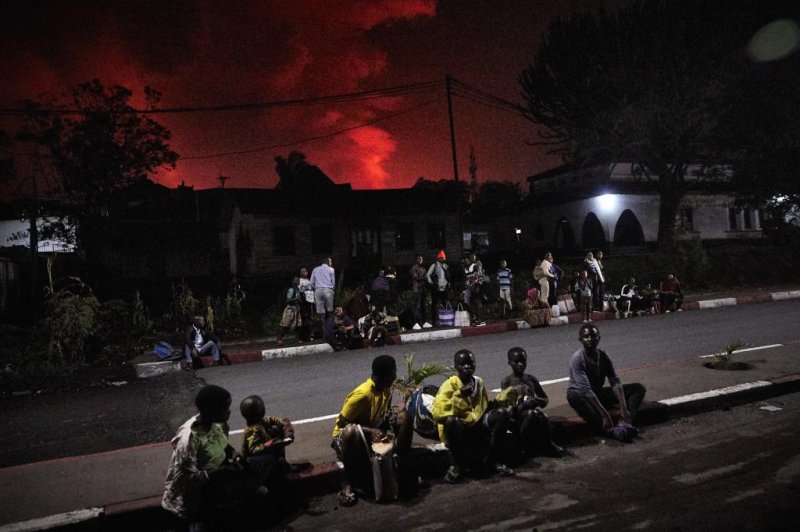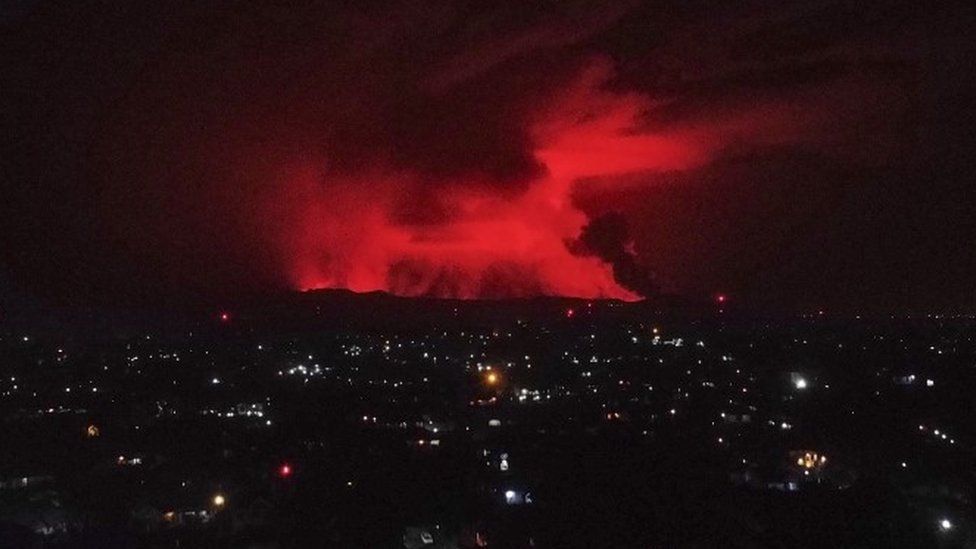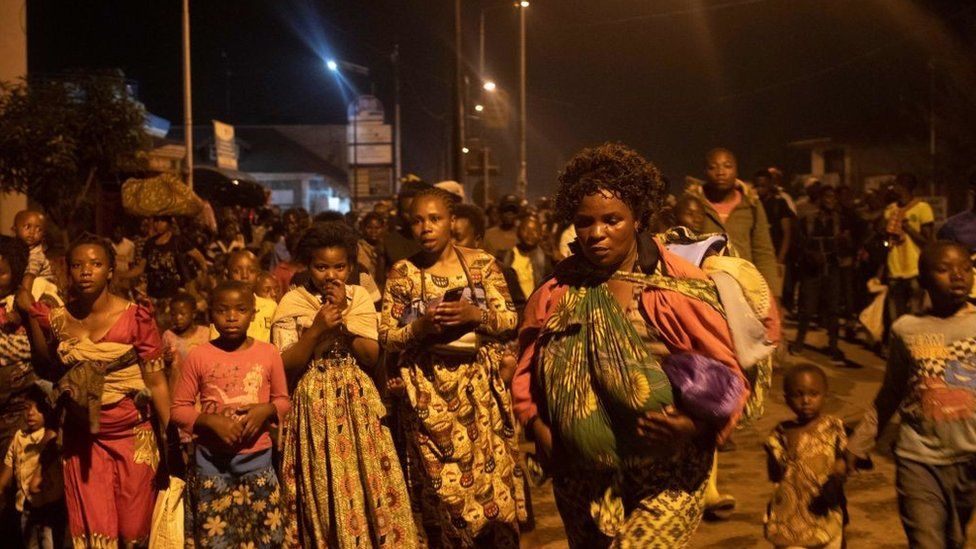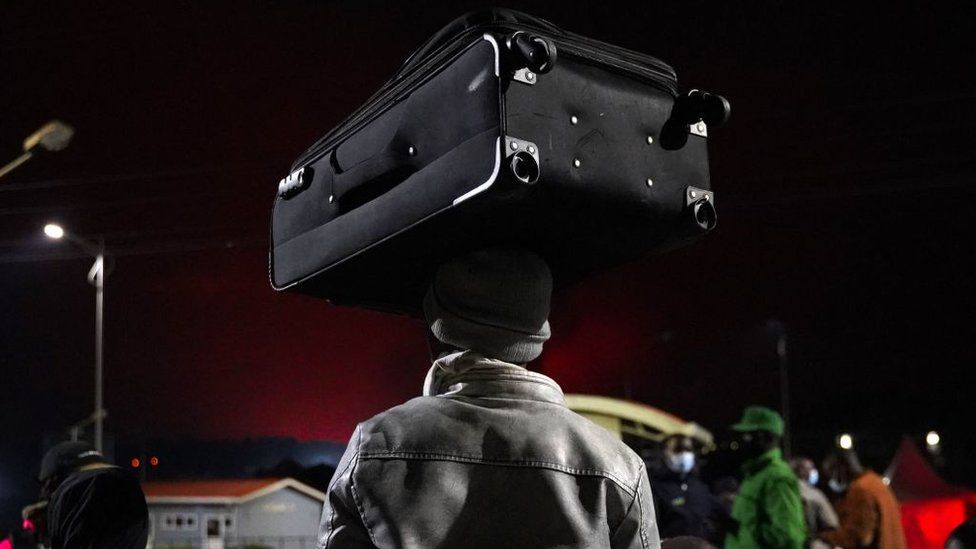UPDATED
Mount Nyiragongo, One of the World’s Most Active and Dangerous Volcanoes, Blows in a Surprise Eruption
Jody Serra
Lava from the eruption of Mount Nyiragongo is seen in Buhene, on the outskirts of Goma, Congo in the early hours of Sunday, May 23, 2021.Photo: Justin Kabumba (AP)
On Saturday, the Democratic Republic of Congo’s Mount Nyiragongo volcano suddenly erupted, forcing thousands to flee to neighboring Rwanda to seek shelter. By Sunday, reports stated that the speed of Nyiragongo’s lava had slowed and that the nearby city of Goma, home to more than one million people, had been spared.
The eruption—which was caused when fractures opened in the volcano’s side and resulted in lava flowing in several directions—took residents, experts, and officials by surprise. According to Reuters, this was in part due to problems at the Goma Volcano Observatory, the scientific entity that monitors Nyiragongo, a volcano near the Democratic Republic of Congo’s border with Rwanda. Volcanologists have struggled to carry out basic checks on the volcano since the World Bank cut off its funding in light of embezzlement allegations.
Observatory officials had not done comprehensive seismic checks on the volcano since October of last year because they didn’t have an internet connection. They managed to reestablish their internet in April when they received funding from a U.S. partner. Officials said that by then, too much time had been lost, however.
“As soon as the internet was restored, we had started recording the warning signals, but since we did not have previous data, we thought it was the start of volcanic activity,” Celestin Kasereka Mahinda, the observatory’s scientific director, said. “Hence this surprise.”

 This general view taken on May 22, 2021 in Goma in the east of the Democratic Republic of Congo shows flame spewing from the Nyiragongo volcano.
This general view taken on May 22, 2021 in Goma in the east of the Democratic Republic of Congo shows flame spewing from the Nyiragongo volcano.
On Saturday, the Democratic Republic of Congo’s Mount Nyiragongo volcano suddenly erupted, forcing thousands to flee to neighboring Rwanda to seek shelter. By Sunday, reports stated that the speed of Nyiragongo’s lava had slowed and that the nearby city of Goma, home to more than one million people, had been spared.
The eruption—which was caused when fractures opened in the volcano’s side and resulted in lava flowing in several directions—took residents, experts, and officials by surprise. According to Reuters, this was in part due to problems at the Goma Volcano Observatory, the scientific entity that monitors Nyiragongo, a volcano near the Democratic Republic of Congo’s border with Rwanda. Volcanologists have struggled to carry out basic checks on the volcano since the World Bank cut off its funding in light of embezzlement allegations.
Observatory officials had not done comprehensive seismic checks on the volcano since October of last year because they didn’t have an internet connection. They managed to reestablish their internet in April when they received funding from a U.S. partner. Officials said that by then, too much time had been lost, however.
“As soon as the internet was restored, we had started recording the warning signals, but since we did not have previous data, we thought it was the start of volcanic activity,” Celestin Kasereka Mahinda, the observatory’s scientific director, said. “Hence this surprise.”

Photo: Moses Sawasawa / AFP (Getty Images)
Although it was a surprise to observatory officials, volcano watchers and experts had been sounding the alarm in recent months about a possible Nyiragongo eruption based on increased volcanic activity and other indicators.
Nyiragongo is one of the world’s most active and dangerous volcanoes and has erupted seven times in the last hundred years. Volcano expert Robin George Andrews noted that one of the reasons Nyiragongo is dangerous is that its lava is very fluid and fast, so fast that it can catch up to speeding cars. Volcanoes in this region also “belch out” a lot of carbon dioxide, he said, which sinks downslope and kills anyone engulfed by it.
News of the volcano’s eruption sparked panic in the surrounding area, which is still haunted by the volcano’s 2002 eruption that killed 250 people and left 120,000 homeless. Although the country’s government said that an evacuation plan had been activated, the official announcement came hours after the sky turned a fiery red on Saturday, the Associated Press reported, after many had already taken it upon themselves to flee.
An army spokesperson told Reuters on Sunday that 13 people had been killed while they were fleeing from the disaster. Of those that died, nine had been involved in a traffic accident and four had tried to escape from a prison in Goma.
Although it was a surprise to observatory officials, volcano watchers and experts had been sounding the alarm in recent months about a possible Nyiragongo eruption based on increased volcanic activity and other indicators.
Nyiragongo is one of the world’s most active and dangerous volcanoes and has erupted seven times in the last hundred years. Volcano expert Robin George Andrews noted that one of the reasons Nyiragongo is dangerous is that its lava is very fluid and fast, so fast that it can catch up to speeding cars. Volcanoes in this region also “belch out” a lot of carbon dioxide, he said, which sinks downslope and kills anyone engulfed by it.
News of the volcano’s eruption sparked panic in the surrounding area, which is still haunted by the volcano’s 2002 eruption that killed 250 people and left 120,000 homeless. Although the country’s government said that an evacuation plan had been activated, the official announcement came hours after the sky turned a fiery red on Saturday, the Associated Press reported, after many had already taken it upon themselves to flee.
An army spokesperson told Reuters on Sunday that 13 people had been killed while they were fleeing from the disaster. Of those that died, nine had been involved in a traffic accident and four had tried to escape from a prison in Goma.

Nonetheless, the number of deaths is expected to increase considerably based on initial eyewitness reports.
Nyiragongo’s lava destroyed hundreds of houses in the eastern part of the Democratic Republic of Congo. CNN stated that five schools had been decimated, while Reuters reported that cooled lava in some areas had turned to rubble. At some sites, it was three stories high, consuming large buildings and sending smoke into the sky.
On Sunday, people were beginning to return to their homes to assess what, if any, damage Nyiragongo had wreaked. After that, the monthslong restoration effort will begin.
By Christen McCurdy

Congolese residents of Goma gather at Rond Point Cercle to flee from erupting Mount Nyamulagira and Mount Nyiragongo part of the Virunga National Park in Goma, Democratic Republic of the Congo Saturday. Photo by Kinsella Cunningham/EPA-EFE
May 22 (UPI) -- Mount Nyiragongo, the volcano in the eastern Democratic Republic of Congo, erupted Saturday evening, prompting evacuations as the lava changed direction.
Residents of the nearby city of Goma were asked to evacuate late Saturday as the government began discussing emergency measures, according to a Twitter post from DRC government spokesperson Patrick Muyaya.

Congolese residents of Goma gather at Rond Point Cercle to flee from erupting Mount Nyamulagira and Mount Nyiragongo part of the Virunga National Park in Goma, Democratic Republic of the Congo Saturday. Photo by Kinsella Cunningham/EPA-EFE
May 22 (UPI) -- Mount Nyiragongo, the volcano in the eastern Democratic Republic of Congo, erupted Saturday evening, prompting evacuations as the lava changed direction.
Residents of the nearby city of Goma were asked to evacuate late Saturday as the government began discussing emergency measures, according to a Twitter post from DRC government spokesperson Patrick Muyaya.
The volcano is one of the largest in the world. Its last large eruption of the volcano took place in 2002 and killed 250 people, CNN reported.
The volcano began erupting at around 7 p.m. local time.
By early Sunday morning the eruption appeared to have subsided, but the evacuation plan was still in effect as vulcanologists monitored the situation.
Initially the government chose not to order evacuations and urged calm as the scale of the eruption was not clear, but officials said the situation was unpredictable.
Tom Peyre-Costa, Norwegian Refugee Council spokesman for West and Central Africa, told CNN the lava was not flowing toward the city, but that if it changed direction, residents would have to evacuate to Rwanda.
Power was later cut off in the area as hundreds of residents began to evacuate toward the nearby border with Rwanda, The Guardian reported.
Mount Nyiragongo: DR Congo residents flee as volcano erupts

During the early hours of Sunday, many residents headed across the nearby Rwandan border, while others went to higher grounds to the west of the city.
Crowds were seen with mattresses and other belongings, fleeing even before the government's announcement, which came several hours after the eruption started
The BBC is not responsible for the content of external sites.
Lava destroys houses after DR Congo volcano erupts
Thousands of people have fled their homes in the Democratic Republic of Congo after a large volcano erupted.
Fountains of high lava burst from Mount Nyiragongo into the night sky forming a thick red cloud over the town of Goma, which has a population of two million.
The lava flow reached the city's airport but has reportedly now stopped.
The volcano, located 10km (six miles) from Goma, last erupted in 2002 killing 250 people and making 120,000 homeless.
Thousands of people have fled their homes in the Democratic Republic of Congo after a large volcano erupted.
Fountains of high lava burst from Mount Nyiragongo into the night sky forming a thick red cloud over the town of Goma, which has a population of two million.
The lava flow reached the city's airport but has reportedly now stopped.
The volcano, located 10km (six miles) from Goma, last erupted in 2002 killing 250 people and making 120,000 homeless.

During the early hours of Sunday, many residents headed across the nearby Rwandan border, while others went to higher grounds to the west of the city.
Crowds were seen with mattresses and other belongings, fleeing even before the government's announcement, which came several hours after the eruption started
Rwandan authorities said about 3,000 people had officially crossed from Goma. The country's state media said they would be accommodated in schools and places of worship.
One Goma resident, Richard Bahati, said he was in his house when he heard screaming. "I got out and saw the sky was red. I am so worried, so worried. I lived through the problem with this volcano in 2002. The volcano devastated all our homes and possessions. That's why I'm scared again this time."
"Everyone is afraid, people are running away. We really don't know what to do," local man Zacharie Paluku told the Associated Press news agency.

One Goma resident, Richard Bahati, said he was in his house when he heard screaming. "I got out and saw the sky was red. I am so worried, so worried. I lived through the problem with this volcano in 2002. The volcano devastated all our homes and possessions. That's why I'm scared again this time."
"Everyone is afraid, people are running away. We really don't know what to do," local man Zacharie Paluku told the Associated Press news agency.

IMAGE COPYRIGHTEPA


IMAGE COPYRIGHTGETTY IMAGES


IMAGE COPYRIGHTGETTY IMAGES
Electricity was out across large areas, and one highway that connects Goma with the city of Beni was engulfed by the lava. There were also reports of earthquakes.
"There is a smell of sulphur. In the distance you can see giant flames coming out of the mountain," resident Carine Mbala told AFP news agency.
An official from Virunga National Park, where the volcano is located, said in a note to staff that the eruption was similar to the one in 2002 and that everyone near the airport should "evacuate without delay".
People have been advised to stay calm, but some complained about the lack of information from the authorities amid conflicting accounts circulating on social media.
Communications Minister Patrick Muyay said on Twitter that the government was discussing "urgent measures" after the prime minister convened an emergency meeting in the capital, Kinshasa.
In a later update, Mr Muyay said the intensity of the lava flow had slowed and an assessment of the humanitarian situation was ongoing.
The UN peacekeeping mission in the country, Monusco, said it was carrying out reconnaissance flights over the city.
Electricity was out across large areas, and one highway that connects Goma with the city of Beni was engulfed by the lava. There were also reports of earthquakes.
"There is a smell of sulphur. In the distance you can see giant flames coming out of the mountain," resident Carine Mbala told AFP news agency.
An official from Virunga National Park, where the volcano is located, said in a note to staff that the eruption was similar to the one in 2002 and that everyone near the airport should "evacuate without delay".
People have been advised to stay calm, but some complained about the lack of information from the authorities amid conflicting accounts circulating on social media.
Communications Minister Patrick Muyay said on Twitter that the government was discussing "urgent measures" after the prime minister convened an emergency meeting in the capital, Kinshasa.
In a later update, Mr Muyay said the intensity of the lava flow had slowed and an assessment of the humanitarian situation was ongoing.
The UN peacekeeping mission in the country, Monusco, said it was carrying out reconnaissance flights over the city.
The BBC is not responsible for the content of external sites.
View original tweet on Twitter

Mount Nyiragongo is one of the world's more active volcanoes but there were concerns that its activity had not been properly observed by the Goma Volcano Observatory, since the World Bank cut funding amid allegations of corruption.
In a report on 10 May, the observatory warned that seismic activity at Nyiragongo had increased.
Last year, the observatory's director, Katcho Karume, told the BBC World Service's Science in Action that the volcano's lava lake had been filling up quickly, increasing the chances of an eruption in the next few years. But he also warned that an earthquake could trigger a disaster earlier.
The volcano's deadliest eruption happened in 1977, when more than 600 people died.

Mount Nyiragongo is one of the world's more active volcanoes but there were concerns that its activity had not been properly observed by the Goma Volcano Observatory, since the World Bank cut funding amid allegations of corruption.
In a report on 10 May, the observatory warned that seismic activity at Nyiragongo had increased.
Last year, the observatory's director, Katcho Karume, told the BBC World Service's Science in Action that the volcano's lava lake had been filling up quickly, increasing the chances of an eruption in the next few years. But he also warned that an earthquake could trigger a disaster earlier.
The volcano's deadliest eruption happened in 1977, when more than 600 people died.
Congo volcano forces mass evacuations
Duration: 01:26
The Democratic Republic of Congo’s Mount Nyiragongo volcano has erupted, forcing thousands to evacuate. Experts say it’s unlikely the eruption will hit the city itself as it flows east, away from Goma. Power was cut in the city, leaving its 2 million residents reeling.
EXCERPTS






No comments:
Post a Comment